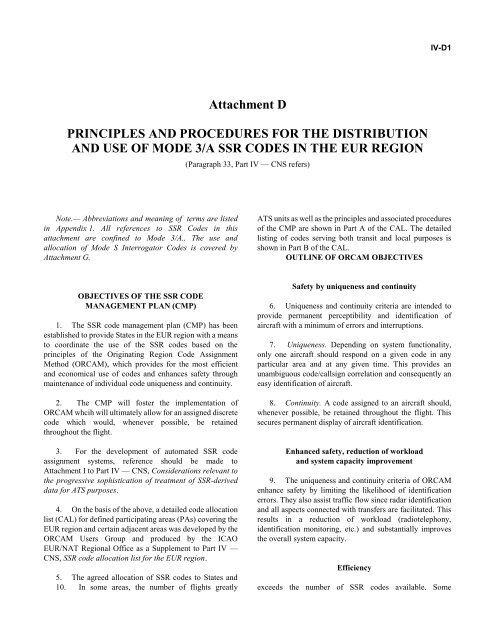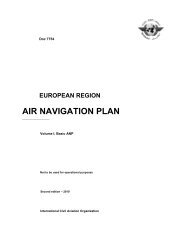7754 Vol 2 Flyleaf - ICAO Public Maps
7754 Vol 2 Flyleaf - ICAO Public Maps
7754 Vol 2 Flyleaf - ICAO Public Maps
You also want an ePaper? Increase the reach of your titles
YUMPU automatically turns print PDFs into web optimized ePapers that Google loves.
IV-D1<br />
Attachment D<br />
PRINCIPLES AND PROCEDURES FOR THE DISTRIBUTION<br />
AND USE OF MODE 3/A SSR CODES IN THE EUR REGION<br />
(Paragraph 33, Part IV — CNS refers)<br />
Note.— Abbreviations and meaning of terms are listed<br />
in Appendix 1. All references to SSR Codes in this<br />
attachment are confined to Mode 3/A.. The use and<br />
allocation of Mode S Interrogator Codes is covered by<br />
Attachment G.<br />
ATS units as well as the principles and associated procedures<br />
of the CMP are shown in Part A of the CAL. The detailed<br />
listing of codes serving both transit and local purposes is<br />
shown in Part B of the CAL.<br />
OUTLINE OF ORCAM OBJECTIVES<br />
OBJECTIVES OF THE SSR CODE<br />
MANAGEMENT PLAN (CMP)<br />
1. The SSR code management plan (CMP) has been<br />
established to provide States in the EUR region with a means<br />
to coordinate the use of the SSR codes based on the<br />
principles of the Originating Region Code Assignment<br />
Method (ORCAM), which provides for the most efficient<br />
and economical use of codes and enhances safety through<br />
maintenance of individual code uniqueness and continuity.<br />
2. The CMP will foster the implementation of<br />
ORCAM whcih will ultimately allow for an assigned discrete<br />
code which would, whenever possible, be retained<br />
throughout the flight.<br />
Safety by uniqueness and continuity<br />
6. Uniqueness and continuity criteria are intended to<br />
provide permanent perceptibility and identification of<br />
aircraft with a minimum of errors and interruptions.<br />
7. Uniqueness. Depending on system functionality,<br />
only one aircraft should respond on a given code in any<br />
particular area and at any given time. This provides an<br />
unambiguous code/callsign correlation and consequently an<br />
easy identification of aircraft.<br />
8. Continuity. A code assigned to an aircraft should,<br />
whenever possible, be retained throughout the flight. This<br />
secures permanent display of aircraft identification.<br />
3. For the development of automated SSR code<br />
assignment systems, reference should be made to<br />
Attachment I to Part IV — CNS, Considerations relevant to<br />
the progressive sophistication of treatment of SSR-derived<br />
data for ATS purposes.<br />
4. On the basis of the above, a detailed code allocation<br />
list (CAL) for defined participating areas (PAs) covering the<br />
EUR region and certain adjacent areas was developed by the<br />
ORCAM Users Group and produced by the <strong>ICAO</strong><br />
EUR/NAT Regional Office as a Supplement to Part IV —<br />
CNS, SSR code allocation list for the EUR region.<br />
Enhanced safety, reduction of workload<br />
and system capacity improvement<br />
9. The uniqueness and continuity criteria of ORCAM<br />
enhance safety by limiting the likelihood of identification<br />
errors. They also assist traffic flow since radar identification<br />
and all aspects connected with transfers are facilitated. This<br />
results in a reduction of workload (radiotelephony,<br />
identification monitoring, etc.) and substantially improves<br />
the overall system capacity.<br />
Efficiency<br />
5. The agreed allocation of SSR codes to States and<br />
10. In some areas, the number of flights greatly exceeds the number of SSR codes available. Some














